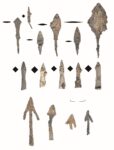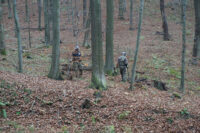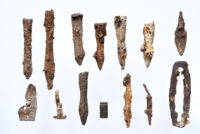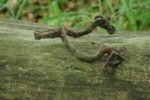 Archaeologists have discovered a previously unknown medieval battlefield on a forested mountain near Sanok, southeastern Poland. The team unearthed more than 200 arrowheads and crossbow bolts from the mid-1300s, the reign of Casimir the Great of Poland.
Archaeologists have discovered a previously unknown medieval battlefield on a forested mountain near Sanok, southeastern Poland. The team unearthed more than 200 arrowheads and crossbow bolts from the mid-1300s, the reign of Casimir the Great of Poland.
The site is on Biała Góra, a peak of the Słonne Mountains. It came to archaeologists’ attention from reports of widespread looting taking place there. It was known to have had a fortified settlement in the late Middle Ages, but it was believed to have been built by the redoubtable Bona Sforza,  Queen of Poland and wife of Sigismund I the Old, in the 16th century. The last time the site was archaeologically investigated was 50 years ago and none of the documentation from that survey is extant today. Treasure hunters flocking to the site with metal detectors suggested there was something to be found there and spurred new archaeological fieldwork.
Queen of Poland and wife of Sigismund I the Old, in the 16th century. The last time the site was archaeologically investigated was 50 years ago and none of the documentation from that survey is extant today. Treasure hunters flocking to the site with metal detectors suggested there was something to be found there and spurred new archaeological fieldwork.
The evidence of extensive looting dotted the hillside — numerous pits on the surface and iron objects of little interest to treasure hunters left behind. The great quantity of arrowheads and bolts were an unexpected discovery because they date to the mid-14th century and there is no specific record of a battle taking place there at that time. There sure was a lot of fighting going on in the area, however.
 After Bolesław-Jerzy II, Piast dynasty ruler of the Ruthenian principality of Galicia, was poisoned to death by local nobles in 1340, Casimir III the Great of Poland inherited the kingdom. This was not an undisputed succession, to put it mildly, and Ruthenian noblemen, the Grand Duchy of Lithuania and the Kingdom of Poland went to war to pursue their claims to the principality. Ultimately Casimir came out on top, and in 1344 he annexed Galicia, adding 20,000 square miles and 200,000 people to the Kingdom of Poland.
After Bolesław-Jerzy II, Piast dynasty ruler of the Ruthenian principality of Galicia, was poisoned to death by local nobles in 1340, Casimir III the Great of Poland inherited the kingdom. This was not an undisputed succession, to put it mildly, and Ruthenian noblemen, the Grand Duchy of Lithuania and the Kingdom of Poland went to war to pursue their claims to the principality. Ultimately Casimir came out on top, and in 1344 he annexed Galicia, adding 20,000 square miles and 200,000 people to the Kingdom of Poland.
Chroniclers record that Casimir’s army took a number of castles when they invaded in 1340. The hillfort on Biała Góra may have been one of them. If so, its defensive response was weak as very few artillery projectiles were  found with the arrowheads and bolts. The fortress was small, encircled by a single earthenware embankment and a dry moat. The highest concentration of bolts and arrows were found within the stronghold and right next to it. The attack came from the south and the remains of the embankment bear evidence of having been burned, so it seems the fort took heavy fire and was unable to dish any out.
found with the arrowheads and bolts. The fortress was small, encircled by a single earthenware embankment and a dry moat. The highest concentration of bolts and arrows were found within the stronghold and right next to it. The attack came from the south and the remains of the embankment bear evidence of having been burned, so it seems the fort took heavy fire and was unable to dish any out.